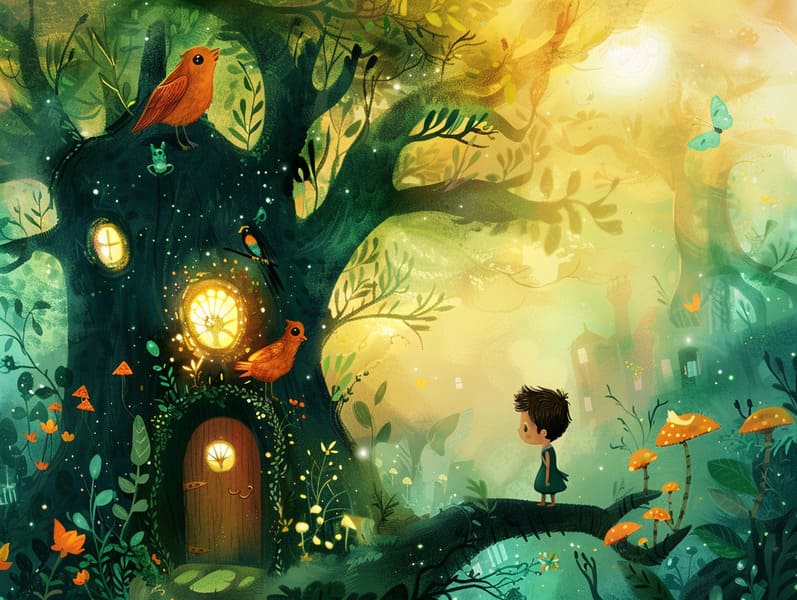Appreciating the Joy of Nighttime Stories: Forming Beloved Occasions with Your Little Ones
Appreciating the Joy of Nighttime Stories: Forming Beloved Occasions with Your Little Ones
Blog Article

Sleepy time is a precious time for families. It’s a time to calm down, get cozy, and delight in the enchantment of nighttime tales.
For ages, sleep stories for kids have been a esteemed tradition, offering more than just a way to nod off. They provide an means for connection, discovery, and igniting vision.
Benefits of Bedtime Stories
Nightly tales for children are not just a way to conclude the day. They play a key role in a child’s maturation and in enhancing the family bond. Here’s why they are valuable:
1. Together Time: Sharing bedtime stories builds a special loving connection between parents and children. It’s a moment of intimacy that helps children feel secure and safe.
2. Vocabulary Building: Absorbing tales helps children develop their communication skills. They acquire new expressions, understand form, and boost their comprehension and comprehension abilities.
3. Creative Development: Nightly stories move them to fantastic worlds, stimulating vision. They see characters, settings, and adventures, which sparks their imagination.
4. Emotional Understanding: Kids' tales often include characters facing problems and emotions. These narratives help kids comprehend and process their own sentiments, fostering emotional skills.
5. Thinking Skills: Absorbing a narrative helps children develop concentration, memory, and problem-solving skills. They gain to follow plots, remember components, and project conclusions.
Incorporating Stories into Bedtime
Forming a sleep-time routine that includes reading aloud stories is straightforward and satisfying. Here’s how to make it a cherished part of your end-of-day custom:
1. Find a Cozy Place: Identify a peaceful place where you and your child can get cozy without interruptions. A relaxing bed or a comfortable reading nook works well.
2. Set a Consistent Time: Choose a specific time each night for storytime. Consistency helps children be prepared and makes the custom easier to follow.
3. Choose Age-Fitting Stories: Find tales that match your child’s developmental stage. Young kids might be drawn to visual books with straightforward tales, while elementary kids may like complex plots with more complicated tales.
4. Engage with the Story: Make sure the tale feel vivid by doing different voices and accents, adding audio effects, and encouraging your child to take part. Ask details about the story to involve them.
5. Create a Soothing Environment: Softly light the lights, use soft voices, and create a relaxing environment to help your child settle down.
Sources for Bedtime Stories
There are many places where you can find great bedtime stories for children. Here are some options to try:
1. Books for Children: Check out your closest library or bookstore to find a diverse selection of bedtime stories for kids. Looking through the options together can be a delightful activity that also lets children to find stories that they enjoy.
2. Online Sources: There are many online platforms that offer free bedtime stories. Sites like children's story websites provide a variety of short stories for kids that you can read on screen. These platforms are great for finding new and diverse stories without expense.
3. Audio Books and Story Apps: For nights when you’re too tired to read, this site try audiobooks or storytelling apps. These can provide a calm narration to read your child a story, ensuring they still get their bedtime story fix. Apps often offer interactive elements that can hold their focus further.
4. Unique Stories: Design your own stories fitting your child’s experiences. Personalized stories can be extremely engaging and meaningful. You can get your child in the narration process, making them a part of the adventure.
Benefits of Brief Stories
Compact tales for little ones are quite beneficial for bedtime. They provide all the good points of longer stories but are more compact, making them perfect for relaxing before sleep. Here’s why short stories are a good choice:
1. Simple and Clear: Short stories are clear and easy for children to follow, even after a long day. They can speedily grasp the plot and enjoy the story without losing interest.
2. Fast Engagement: These stories immediately engage children, catching their attention and creativity. This makes them great for keeping bedtime rituals easy yet enjoyable.
3. Variety and Flexibility: Concise narratives give for variety in your bedtime narrative. You can get a different story each night, keeping the habit exciting and exciting for your child.
4. Saves Time: For busy parents, compact stories are a efficient way to ensure children still get their nightly dose of storytelling. They fit well into a hectic schedule while still offering the full good aspects of a bedtime story.
Why "Read Me a Story" is Powerful
The simple phrase, “Will you read me a story?” can give a world of magic for children. Answering to this request not only fulfills a child’s need for attention and engagement but also builds lasting experiences. Here’s why it’s wonderful:
1. Attachment: Reading aloud to your child develops a deep emotional relationship. It’s a time for closeness, sharing, and bonding.
2. Heritage: Starting a bedtime story practice creates a valued tradition that children enjoy every night. It’s a tradition that can be transferred through generations.
3. Development Together: As you tell stories, you’ll observe your child’s maturation and advancement. Their queries, reactions, and understanding of the stories grow, offering insights into their developing minds.
4. Safe Environment: Bedtime stories provide a safe space for children to deal with emotions, face fears, and find comfort in the reliable presence of a parent.
Final Thoughts
Children’s bedtime stories are a powerful tool for growing a child’s development and crafting unforgettable experiences of closeness.